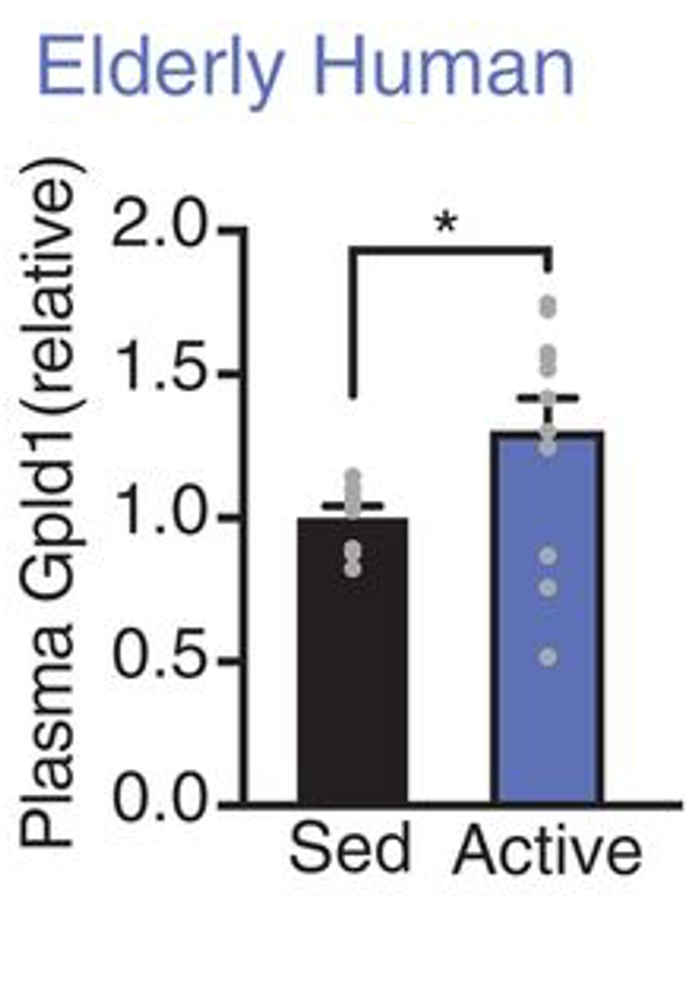Key Points:
- Sedentary old mice injected with the plasma of exercised old mice exhibit younger brains.
- A molecule called Gpld1 was associated with contributing to this brain rejuvenation.
- Other molecules that can mimic the anti-aging effects of exercise are discussed.
The benefits of exercise, including reduced stress, reducing the risk of cognitive decline, and lowering the risk of early death cannot be overstated. However, for varying reasons, many individuals, particularly elderly individuals, are unable or unwilling to exercise consistently. It follows that, in lieu of physical exercise, sedentary individuals can supplement with molecules that mimic exercise, potentially leading to a longer life. As published in Science, researchers at the University of California San Francisco (UCSF) pursued such molecules.
“If there were a drug that produced the same brain benefits as exercise, everyone would be taking it. Now our study suggests that at least some of these benefits might one day be available in pill form,” said senior author Saul Villeda, PhD.
Exercise Benefits Transferred Via Blood
To confirm the anti-aging effects of exercise on the brain, the UCSF researchers gave old mice continuous access to a running wheel for six weeks. These mice were 18-months-old, an age roughly equivalent to 55 human years. The results showed that, compared to sedentary old mice, the exercised mice exhibited increased neurogenesis—brain growth.
Accompanying the increase in neurogenesis was an elevation in BDNF (brain-derived neurotrophic factor), an important protein that plays a key role in the growth of new neurons. Reflecting the increase in neurogenesis and BDNF, the exercised mice also showed improvements in learning and memory, a critical measure of cognitive enhancement.
In verifying the anti-aging benefits of exercise on the brain of old mice, the researchers next attempted to transfer these benefits to a new group of sedentary old mice. They took the blood of the exercised mice and isolated the plasma (portion of blood without cells or platelets). Plasma was also extracted from the sedentary old mice that the exercised old mice were compared to.
The results showed that, compared to the mice injected with plasma from the sedentary mice, the mice injected with plasma from the exercised mice showed heightened neurogenesis, increased BDNF, and improved learning and memory. These findings revealed that some factors within the plasma of exercised mice contribute to the anti-aging benefits of exercise on the brain since neurogenesis, BDNF, and learning and memory tend to decline with age.

The Exercise Mimicking Molecule
The researchers next sought to identify the molecules in the plasma of exercised mice responsible for contributing to the reversal of brain aging. In doing so, they found that 30 proteins increased in response to exercise in the old mice. Of the 30 proteins, they chose to investigate one called Gpld1 because it had not been previously linked to aging, neurogenesis, or cognition.
“We figured that if the protein had already been investigated thoroughly, someone would have stumbled upon this effect,” Villeda said. “I like to say – if you’re going to take a risk by exploring something new, you might as well go big!”
To confirm the relevance of Gpld1 in humans, the researchers also measured Gpld1 levels in response to exercise in elderly individuals. It was found that, compared to sedentary elderly individuals, exercised elderly individuals had higher levels of plasma Gpld1. These findings demonstrate that Gpld1 may contribute to the anti-aging effects of exercise on the brain in humans.

Furthermore, the researchers found that Gpld1 was primarily produced in the liver after exercise. With this knowledge, they used a special technique to over-produce Gpld1 in the liver of old mice. Remarkably, this led to increased neurogenesis, elevated BDNF, and improved learning and memory in the old mice. These findings suggest that Gpld1 alone can mimic the anti-aging effects of exercise on the brain.
“To be honest, I didn’t expect to succeed in finding a single molecule that could account for so much of the benefits of exercise on the brain. It seemed more likely that exercise would exert many small, subtle effects that add up to a large benefit, but which would be hard to isolate.” Villeda said. “When I saw these data, I was completely floored.”
Further experiments showed that Gpld1 did not cross the blood-brain barrier, suggesting that Gpld1 acts on other molecules, which in turn may provide the beneficial effects of exercise on the brain. The researchers found that these molecules were related to blood clotting. Notably, the researchers did not show that injecting Gpld1 into the bloodstream could mimic the effects of exercise, and it is unclear whether this was tested.
NAD+ Boosters May Serve as Exercise Mimetics
Other than Gpld1, studies have shown that other anti-aging molecules may serve as exercise mimetics, including NAD+ (nicotinamide adenine dinucleotide) precursors, which include NR (nicotinamide riboside) and NMN (nicotinamide mononucleotide). Acute exercise has been shown to boost NAD+ metabolism, which is what NAD+ precursors can do in some individuals. A class of anti-aging compounds called senolytics also appears to mimic exercise. Exercise has been shown to reduce senescent cells — cells that accumulate with age and promote chronic diseases. Senolytics also reduce senescent cells.
However, other than elevating NAD+ levels and reducing senescent cells, exercise also provides a myriad of other cellular changes that promote health and longevity. Thus, NAD+ precursors and senolytics cannot completely replace physical exercise. As research in the field of biological aging continues, scientists may discover the full complement of anti-aging compounds that can more completely mimic the effects of exercise.